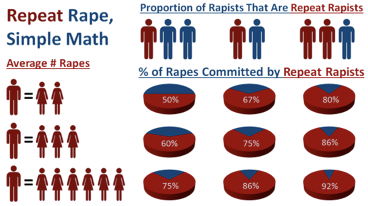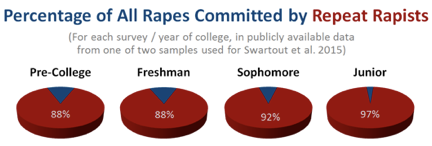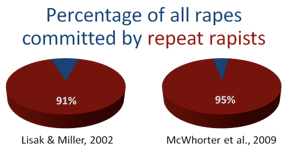Research suggests that about two-thirds of college rapists are repeat offenders, who account for the great majority of rapes (over 90%), and that about one-fourth of college rapists admit to committing rapes over multiple years of college.
Executive Summary
In many studies researchers have found that 4-16% of college men report committing rapes. Only two studies of college men had large enough samples to investigate what percentage of rapists are repeat rapists, one a study of typical 18-22 year old men at large university and the other of older men at a commuter school. Both studies found that two-thirds or more of college rapists are repeat rapists who have raped four or more times on average, even within a single year of college.
Due to simple math, those two-thirds of college rapists who average four or more rapes each account for the vast majority of college rapes, around 90% or more. A study of college-aged Navy recruits had the same findings, which suggests that these statistics are not determined by whether men are college students or not. Finally, in the study of typical college men about 25% of rapists, the majority of whom are repeat offenders, admitted to raping in more than one year of college. However, that 25% statistic depends on rapists, including repeat rapists, being equally honest, year after year, on survey questions about rape.
It is critical that journalists, policy makers and everyone else working to address campus sexual assault understand these basic statistics on college rapists and repeat rape, and avoid apples-to-oranges comparisons of statistics about completely different things.
FYI: Callisto Vault is a free resource for college students. Anyone with an edu email address can create an encrypted account; enter a time-stamped record of the assault; choose to use Callisto’s Matching System to learn if their perpetrator harmed someone else; match with the perpetrator’s other victims (even at other schools); and if there’s a match, get FREE confidential legal-options counseling. Watch 90-second video.
Introduction
This page presents, in simple terms with links to scientific research, statistics on repeat rape among college men.
It presents the available evidence on the percentage of college men who acknowledge committing rape on surveys; the percentage of rapists who are “repeat rapists,” or admit to raping more than once; the percentage of all rapes that are committed by repeat rapists; and the percentage of rapists who admit to perpetrating rape during more than one year of college.
How is “rape” defined here, and for most research studies? Completed or attempted vaginal, anal or oral sexual intercourse through the threat or actual use of force, or because the victim is incapacitated by drugs or alcohol. (Note: penetration can be with any body part or object, not just the penis.)
Attempted rape is included not only because it is a crime, but because it can be very traumatic and harmful to victims. Thus almost all researchers include attempted rape in their studies and statistics.
What Percentage of College Men Admit to Committing Rape?
Survey studies of college men have found rates between 4% and 16% (e.g., Lisak & Miller, 2002; Abbey et al., 2012; Thompson et al., 2013).
Importantly, these surveys do not use the words “rape” or “sexual assault.” Rather they use clear behavioral descriptions of rape. And those descriptions explicitly state that penetration occurred against the woman’s will (e.g., “even though she did not want to”). So none of the rapes or attempted rapes reported by men in these studies had anything to do with perpetrators believing the women had consented.
Please note that we can’t know whether the men’s responses are accurate or honest reflections of their actual behavior. Some men do not admit to themselves – let alone to researchers, even on an anonymous or confidential survey – that they have committed such acts even when they have. So these 4-16% statistics and the others presented here are likely underestimates to some extent.
Among College Men Who Rape, What Percentage Are Repeat Rapists?
Research suggests that two-thirds or more of college men who commit rape are repeat rapists – or at least acknowledge committing rape and admit to raping more than once.
Because a relatively small percentage of men commit rape, only large studies can generate useful statistics on the percentage who are repeat rapists.
Fortunately, there is a large study of about 950 “typical” college men; that is, 18-22 year olds who attended a large southern university where most students live on campus. (This is one of two datasets used for a flawed 2015 paper by Kevin Swartout and colleagues.) Its data include the number of rapes and attempted rapes that each man reported committing on successive surveys covering each year of college, which means the study’s researchers could have conducted analyses and published findings on (1) what percentage of rapists are repeat rapists, and (2) how many rapes they report committing. They have not done so, but the data are publicly available, so any researcher can conduct those analyses (or verify others’ analyses).
For that study men were surveyed in September of their freshman year, and then at the ends of freshman, sophomore, junior, and senior years. (Because men dropped out every year, by senior year there were too few rapists to generate usable statistics.)
Using the publicly available data from this study of typical college men, I conducted the analyses that yielded the statistics reported here. Importantly, my findings are based on the most conservative possible estimates of how many rapes and attempted rapes the men in that study committed.
(For those wanting methodological details: Because of additional dropouts at each survey wave, we cannot know whether or how many (additional) rapes were subsequently committed by men no longer in the study. Thus the percentage of rapists who are repeat rapists can only be calculated for each separate survey wave, including each year of college. My estimates here are the most conservative possible because: [a] reports of “3 to 5” rapes on single survey items were counted as 3 and “more than 5” were counted as 6; and [b] all potential double-counting of rapes was eliminated. While some repeat rapes may have been perpetrated against one woman, that’s still repeat rape and very harmful to the repeatedly raped woman. For details, see this presentation and the SPSS syntax with the code used to create number-of-rapes variables, conduct frequency analyses, and yield statistics.)
As shown graphically below, in that sample of typical college men, the percentage of acknowledged rapists who also admitted to raping and/or attempting to rape more than once, indeed an average of more than 4 times in single years of college, ranges from 69% to 88%.

A lower but still high percentage of repeat rapists (63%) was found in a study of less typical college men published in 2002 by David Lisak and Paul Miller (colleagues of mine, using data collected in part by me). That study’s approximately 1800 men were an average of 26 years old, part-time and full-time students, and all commuters who did not live on campus. (A very small number may have been university staff.)
In 2009 Stephanie McWhorter and colleagues published a study of more than 1100 mostly college-aged (20 on average) United States Navy recruits. Consistent with the two studies of college students, 71% of the rapists were repeat rapists.
Together these studies suggest that two-thirds or more of college rapists are repeat rapists and that, when it comes to perpetrating rape, men living on a college campus are not essentially different from older men commuting to college classes or college-aged men engaged in other pursuits.
What Percentage of College Rapes Are Perpetrated by Repeat Rapists?
Before we get into the research findings, consider this: simple math ensures that the great majority of rapes are committed by repeat rapists.
That is, the percentage of rapists who are repeat perpetrators, multiplied by the average number of rapes they commit, determines the percentage of all rapes that are committed by repeat rapists. This is shown graphically below. Along the top are three different potential proportions of rapists that are repeat rapists: one-third, one-half, and two-thirds. On the left are three potential average numbers of rapes they commit: two, three, and six. Via simple math, the values of these two variables determine the percentage of all rapes that are committed by repeat rapists, i.e., the red pie sections.
As you can see, the only hypothetical scenario where repeat rapists don’t commit more than half of all rapes is when they are just one-third of rapists and commit only two rapes. And if repeat rapists are two-thirds of all rapists, then the lowest possible percentage of rapes committed by them is 80%.

Now, let’s consider what the research shows, again starting with the publicly available data from that study of typical college men, one of two samples used by Swartout and colleagues. As shown above, the repeat rapists are 61% of all rapists for pre-college (from age 14), 69% for freshman year, 71% for sophomore year, and 88% for junior year. And the average numbers of rapes they reported committing are 4.6 for pre-college, 3.4 for freshman year (from September to May, equivalent to 4.5 in 12 months), 4.3 for sophomore year (in 12 months, including the prior summer), and 5.2 for junior year (12 months).
(Methodological details: The researchers who created the public database for this study [inexplicably] re-coded “missing” and “no response” values of responses to survey items into “never” having raped during that year of college; for my calculations, averages were calculated as conservatively as possible, with item responses of “3 to 5” coded as 3 and “more than 5” as 6, and I eliminated all potential double-counting of rapes. Thus my frequency estimates are definitely under-estimates.)
Applying the simple math, these percentages and averages yield the results below.

In short, the only available data from a study of typical college men shows that, in every year of college, the great majority of rapes are committed by repeat rapists.
(These statistics can be independently verified by any researcher who accesses the publicly available data, can conduct simple frequency analyses, gets to know the data and creates the appropriate variables [based on the dataset’s X_____ variables, e.g., XFORCESI]. My SPSS code is available here.)
Again, those findings from a study of typical college men are mirrored by those from the Lisak and Miller and McWhorter et al. studies of older commuter students and Navy recruits. In those studies repeat rapists are 63% and 71% of the rapists, respectively, and the average number of rapes they report committing is around six (5.8 and 6.4). As shown below, the simple math dictates that, for these two studies, over 90% of all rapes that the men reported committing were perpetrated by the repeat rapists.

(Methodological details: In the Lisak and Miller and McWhorter et al. studies, due to both of the survey designs, the researchers may have over-estimated the numbers of rapes the men committed; for example, a man might admit to 3 rapes on a question about forced intercourse and 3 rapes on a question about alcohol-facilitated rape, but those might be the same 3 rapes, not 6 different rapes. If so, 91% and 95% statistics would be over-estimates. As noted above, for the 88-97% statistics on the typical college sample, any risk of double-counting was eliminated and the statistics must be under-estimates.)
In summary, the available data on college rape – including from a sample of 950 “typical” college men – indicate that repeat rapists are the majority of rapists (around two-thirds or more) and they commit the vast majority of rapes (around 90% or more).
What Percentage of Rapists Admit to Raping During Multiple College Years?
This is the key statistic reported by Swartout and colleagues in their flawed 2015 paper in JAMA Pediatrics – not the percentage of rapists who are repeat rapists, and not the percentage of rapes committed by repeat rapists.
For that paper Swartout and colleagues created a new and restrictive definition of “serial” rapist: a man who admits to committing at least one rape (on more than one survey) in more than one year (of college).
Critically, for that paper Swartout and his co-authors did not attempt to determine whether men were repeat rapists or not – that is, whether they admitted to raping and/or attempting to rape more than once vs. only one time. (As noted above, by the most conservative possible estimation, repeat rapists in their sample reported committing an average of 4.3 to 5.2 rapes in individual years of college.)
However, because Swartout et al. were only focused on men who admitted to committing rape in more than one year of college – who they call “serial” rapists – men who did not also admit to committing rape on surveys about other years of college were not defined as “serial” rapists. This is the case even for men who admitted to committing “more than 5” rapes in just one particular year of college. Swartout and colleagues never use the term “repeat rapist” to refer to men in their own data sets; they only use “serial rapist,” as they have newly defined it.
Also, and this is very important, the validity of their definition and of their analyses depend on rapists, including repeat rapists, being honest on every survey about whether they raped during that year. Put differently, a man who admits to committing more than five rapes freshman year but when surveyed a year later denies raping at all during sophomore year is, by their definition of “serial” rapist, assumed to be telling the truth.
For these reasons, the one-in-four statistic reported in the Swartout et al. 2015 paper is not about “repeat rape” – or even about “serial rape” as many people understand that term. Their 25% statistic only refers to the percentage of rapists (most of whom are repeat rapists, as shown above) who admit to committing at least one rape in more than one year of college.
Unfortunately, journalists have been citing Swartout et al.’s one-fourth statistic right along with the two-thirds statistic, as if both pertain to “repeat rape” and are simply different values of the same statistic from different researchers measuring the same thing. Some have written that Swartout and colleagues’ paper and its one-in-four statistic contradict or even refute the Lisak and Miller paper and its findings that about two-in-three college rapists are repeat rapists who commit the great majority of rapes.
But as I have made clear, neither is true: Multiple research studies – including the one of typical college students by Swartout and his colleagues – have found that about two-thirds (or more) of college rapists are repeat rapists, and that those repeat rapists commit the great majority of rapes (and attempted rapes).
(See also Foubert and colleagues’ [2019] study of more than 12,000 college men from 49 different schools, in which 5.1% acknowledged “taking advantage of someone sexually while under the influence of alcohol.” Most men who reported doing so (57%) were repeat offenders who reported committing an average of at least 5 alcohol-involved sexual assaults each and accounted for 87% of all such assaults.)
Summary and Conclusion
Many studies have found that 4-16% of college men admit, on anonymous or confidential surveys, to having committed at least one rape or attempted rape.
Fewer studies have looked at the percentage of college rapists who are repeat rapists, because doing so requires sufficiently large samples. But those studies have consistently found that around two-thirds or more of men who rape do so more than once, and that those repeat rapists perpetrate an average of four or more rapes and/or attempted rapes – even within a single year of college.
Due to simple math, this means that the great majority of rapes – around 90% or more – are perpetrated by repeat rapists.
There is some evidence – which is dependent on repeat rapists honestly admitting to having committed at least one additional rape on at least one later survey – that only around 25% of college men who acknowledge committing rape also admit to raping during more than one year of college.
In conclusion, for journalists and others who want to write about statistics on repeat rapists among college students, especially if they want to include the one-in-four statistic associated with Swartout and colleagues’ research and their new and restrictive definition of “serial rapist,” some variant of the sentence below will (1) be accurate and (2) not confuse or mislead their readers.
Research suggests that about two-thirds of college rapists are repeat offenders, who account for the great majority of rapes (over 90%), and about one-fourth of college rapists admit to committing rapes over multiple years of college.
